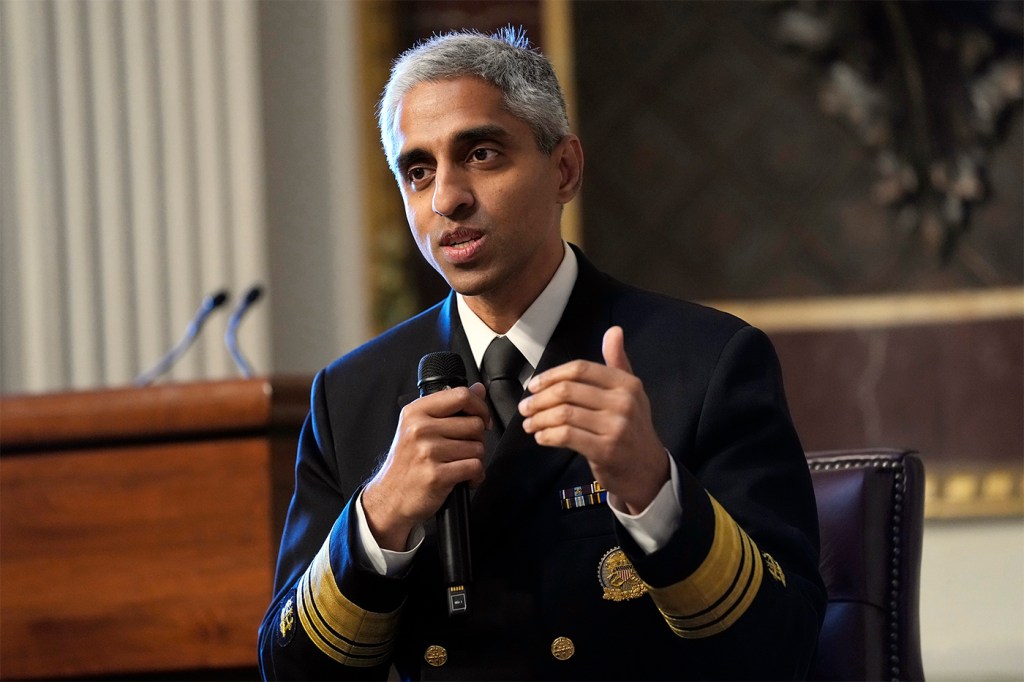The US surgeon general wants a warning label on social media. Here’s why this may not work, according to Northeastern experts
Applied psychology professor Rachel Rodgers did research that found warning labels on digitally altered photos are “ineffective.” Would a warning label on social media sites be effective?

On Monday, U.S. Surgeon General Vivek Murthy said he wants Congress to allow for warning labels to be placed on social media sites advising of the negative effects the platforms could have on adolescents’ mental health.
The warning labels would be like ones on tobacco and alcohol products, warning that “social media has not been proven safe,” Murthy wrote in an op-ed for the New York Times. He said some research shows that teens spending more than three hours a day on social media have a higher risk of mental health problems.
But the efficacy of such a label — and whether it’d even be allowed — is up for debate, according to Northeastern University experts.
“Warning labels on media images that have been digitally modified are ineffective in preventing the negative effects of media images on body image at best,” said Rachel Rodgers, an associate professor of applied psychology at Northeastern. “At worst they actually exacerbate these effects.”


Rodgers, who specializes in body image, did a meta-analysis of the experimental literature on this topic and found that there is no benefit to body image when it comes to labels on altered photos.
“Moreover, from a systemic perspective, using warning labels allows harmful industry practices to continue rather than leveraging systemic change, and places the burden on the user to protect themselves from something harmful,” Rodgers said. “When the user is a vulnerable young person, this is not an ethical stance.”
The use of such a label would have to be passed by Congress, but it’s also unclear if it would be upheld by the Supreme Court if it were challenged in court. And many such health labels have faced legal challenges.
Claudia Haupt, a professor of law and political science at Northeastern, said that the Supreme Court has been “aggressive” in enforcing the First Amendment and using it as an argument against warning labels.
Featured Posts
There’s been litigation over warning labels in the past, Haupt said, with companies arguing against putting graphic labels on cigarette cartons and signs at crisis pregnancy centers stating they’re not health care providers.
“The big problem with compelled disclosures is basically you’re telling the company to tell the consumer that their own product is dangerous,” Haupt said. “They don’t particularly like that because who wants to say, ‘The thing I’m trying to sell you might actually cause you harm.’”
She added that it’s likely social media companies would push back on a warning, if one were passed, claiming it’s infringing on their First Amendment rights.
In the past, she said, the Supreme Court has sided with companies on this. Haupt, along with Wendy Parmet, director of Northeastern’s Center for Health Policy and Law, published research on this, looking into the court’s history when it comes to health warnings.
“Over time, the balance has shifted,” Haupt said of the pair’s findings. “When public health would win in the past, free speech would be more likely to win. That would be relevant for all kinds of contexts where speech is used to inform the public about a public health danger. … The First Amendment gets more and more leeway in the courts so it becomes more and more difficult to actually compel companies to warn about their products.”
Haupt said Murthy’s push for a label that specifically targets young people might be better received, but ultimately it will come down to the precedent set in the crisis pregnancy center case that said disclosures have to be “purely factual and uncontroversial.”
“The First Amendment itself doesn’t say anything about this,” Haupt said. “It’s just the court’s interpretation. … You can debate what’s purely factual, what’s uncontroversial. And then we get back to what kinds of harm does social media consumption potentially cause and is that worth limiting speech? That’s the ultimate question. It’s really hard to predict what the court will do with this.”
What could be a more effective approach to combating the negative effects of social media, Rodgers said, is including social media literacy education in youth programming and developing policies and practices to focus on risk protection while also teaching youths to use social media in a positive way. The former could involve guidance from adults, including parents who can monitor children’s use.
“I think social media use, when thoughtful, can bring a number of benefits,” Rodgers said. “This is not the same as being ‘safe.’ I do believe there are ways of using social media in which the benefits largely outweigh any detrimental effects. However, this would be a very careful, deliberate, in some ways limited and controlled use of social media, informed by strong media literacy, and strategically implementing and leveraging the affordances of platforms to tailor one’s online experience.”











